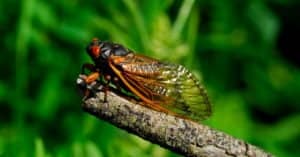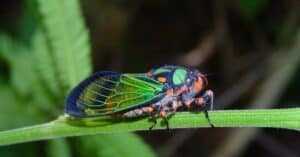Have you seen a really big bee outside? We’re talking really, REALLY big – a scary-looking wasp that is 2 inches in length.
You may be wondering, did I just see a murder hornet? Should I kill it? Should I call the authorities? Am I in danger? Here, we’ll examine how budding entomologists in North America can tell the difference between the native cicada killer wasp and the possibly invasive Japanese hornet.
Cicada Killer vs Japanese Hornet
Eastern cicada killers (Sphecius speciosus) and Japanese hornets (Vespa mandarinia) don’t normally occupy the same continent, but sightings of Japanese “murder hornets” in the U.S. have sparked many misidentifications of the cicada killer, a large and harmless native wasp.
Since these insects are about the same size, how can you tell them apart? Consider where you sighted it, the coloration, and the stinger.
Comparing Cicada Killer vs Japanese Hornet
Consider the following differences between cicada killers and Japanese hornets.
| Cicada Killer | Japanese Hornet | |
|---|---|---|
| Geographic Location | The United States, concentrated in the east | Asia, Russia, and North America’s Pacific Northwest |
| Coloration | Darker with fewer yellow bands | Yellow head, yellow and brown-banded abdomen – Long, sharp stinger; aggressive |
| Stinger | Black, blunt stinger; non-aggressive | Long, sharp stinger; aggressive |
The 3 Key Differences Between Cicada Killer vs Japanese Hornet
If you happen to see a two-inch-long bee, take note of these three features in order to identify it.
Geographic Location
The Japanese hornet and cicada killer wasp have geographically distant native habitats. The Japanese or Asian giant hornet inhabits much of Asia, as far north as Russia. If you see a large wasp there, it is almost certainly the Japanese hornet, the largest hornet in the world.
The eastern cicada killer, the largest and most well-known cicada killer species, lives in North America. Its range is concentrated on the eastern two-thirds of the continent, especially the east coast. If you spy a very large hornet in North America, it is almost certainly an eastern cicada killer.
Appearance
Next, you can look at the overall color of the wasp. The abdomen is the most distinctive. Cicada killers have black abdomens with three interrupted bands of yellow, while Japanese hornets have many unbroken, alternating bands of brown and orange-yellow.
Next, look at the head. Japanese hornets have an orange or yellow head, while cicada killers have a dull brown head with a small yellow patch on the face.
Finally, look at the thorax. Japanese hornets have a dark brown to a black thorax, while cicada killers have a lighter brown to an orange thorax.
Stinger
Japanese giant hornets are known for their painful sting. They have a long, sharp stinger visible at the tip of the abdomen.
Cicada killers do have a stinger, but it appears blunt by contrast. The tip of the abdomen is black and rounded.
Sting behavior can also indicate the species. If you receive a painful sting from a 2-inch-long wasp, you’ve probably encountered a murder hornet. Murder hornets inject a large amount of venom into their victims, which could prove fatal in humans, though this is a rare occurrence. They can also bite!
Male cicada killers can’t sting, and females are non-aggressive and will only sting if severely threatened.
Up Next…
- Wasps Predators: What Eats Wasps? Want to eliminate wasps from your presence? Find out wasp predators.
- 10 Incredible Asian Giant Hornet Facts Murder hornets are frightening with their 2 inch stingers and large size. Find out more about this nightmare of a hornet!
- What Do Hornets Eat? 11 Foods for This Bug Hornets are formidable hunters. Find out what they eat here.
Thank you for reading! Have some feedback for us? Contact the AZ Animals editorial team.







